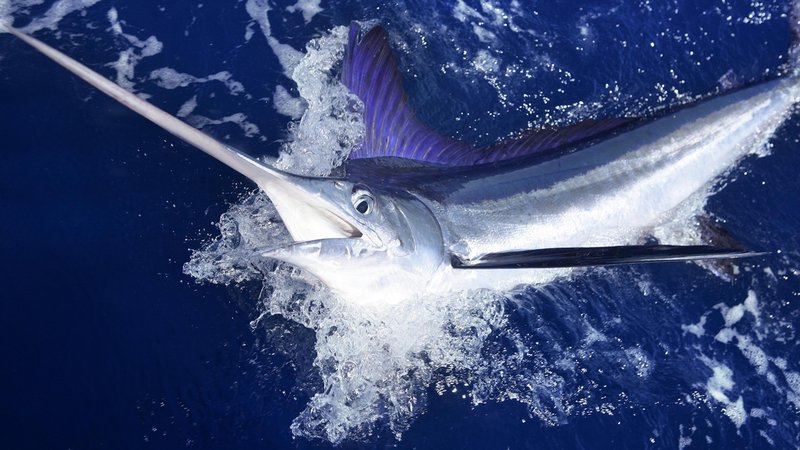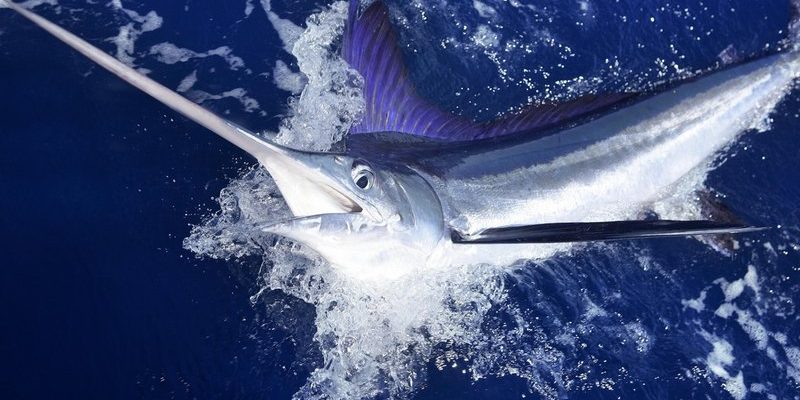
The blue marlin is one of the most captivating creatures of the ocean, known for its stunning beauty and impressive speed. Imagine a sleek, powerful fish gliding through the water with grace and agility, its deep blue body shimmering under the sun. This magnificent species is not just a sight to behold; it plays a vital role in marine ecosystems and is popular among sport fishermen for its strength and size.
Now, you might be wondering, what exactly makes the blue marlin so fascinating? From its incredible hunting skills to its unique anatomy, there’s a lot to explore about this remarkable animal. In this article, we will dive into the world of the blue marlin, unraveling its habits, habitats, and the challenges it faces in the wild.
Physical Characteristics of the Blue Marlin
The blue marlin is easy to recognize thanks to its distinct features. Typically, these fish can grow up to 10 feet long and weigh over 1,000 pounds! Their bodies are sleek and streamlined, designed for speed—some say they can swim as fast as 60 miles per hour. The blue marlin’s color is a combination of deep blue on top and silver-white on the underside, a pattern that offers excellent camouflage while hunting.
One of the most striking features of the blue marlin is its elongated bill, similar to a sword. This bill isn’t just for show; it serves as a powerful tool for slicing through schools of fish, making hunting more efficient. The marlin’s sharp teeth, arrayed along its jaw, help it grasp slippery prey with ease. With this combination of speed and weaponry, it’s no wonder the blue marlin is often referred to as the gladiator of the sea.
Their large dorsal fin, often seen cresting above the water, adds to their impressive silhouette. When these fish leap from the water, it’s truly a breathtaking sight. Sports fishermen often dream of catching a blue marlin largely due to their beauty and the challenge they present when reeling one in.
Habitat and Distribution
The blue marlin is primarily found in warm waters, thriving in tropical and subtropical regions of the Atlantic, Indian, and Pacific Oceans. They typically inhabit the open ocean, known as the pelagic zone, where they can roam freely and hunt effectively. These fish prefer deeper waters but can also be found near the surface, especially when pursuing prey.
Blue marlins migrate based on water temperatures and food availability. During warmer months, they may travel to shallower areas, while in cooler seasons, they tend to venture into deeper waters. This migratory behavior helps them find optimal conditions for feeding and breeding. Understanding their migration patterns is crucial for conservation efforts, as they often cross international waters and are influenced by human activity.
Many sport fishermen target blue marlin during specific seasons, which can vary depending on the region. Places like the Caribbean and Hawaii host tournaments, attracting anglers from around the globe. The thrill of catching a blue marlin is not just about the size, but also the adventure of fishing in stunning ocean settings.
Diet and Hunting Behavior
The blue marlin is a carnivorous predator, primarily feeding on smaller fish such as tuna, mackerel, and swordfish. Its hunting strategy is one of stealth and speed. They often hunt alone or in small groups, using their keen eyesight to spot schools of fish from a distance. When they do locate a school, they charge in with incredible speed, using their bills to stun or injure the fish, making them easier to catch.
Interestingly, blue marlins have been observed displaying both solitary and pack hunting behaviors. When in packs, they can corner schools of fish, making it easier for them to feed. This cooperative hunting strategy highlights their intelligence and adaptability in the wild. They are not just mindless hunters; their actions reveal a complex understanding of their environment.
During feeding times, the blue marlin engages in breathtaking acrobatics, leaping out of the water to shake off hooked prey or simply to celebrate a successful catch. This behavior is not just visually stunning; it also showcases their incredible power and agility. Watching a blue marlin in action is a thrilling experience for anyone lucky enough to observe it in the wild.
Reproduction and Lifespan
Blue marlins are known to spawn in warmer waters, with the breeding season varying by location. Females can produce up to a million eggs at a time, releasing them into the ocean where fertilization occurs externally. These eggs float and drift with ocean currents, offering the larvae a chance to survive in the vast sea. However, only a small percentage of eggs hatch and survive to adulthood, making reproduction a vital aspect of maintaining their populations.
Juvenile blue marlins grow quickly, reaching maturity at around 4 to 5 years of age. They can live much longer, with lifespans estimated at up to 10 to 15 years in the wild. Understanding their lifecycle is crucial for conservation efforts, as overfishing and environmental changes threaten their populations. Protecting breeding grounds and managing fishing practices are essential to ensuring future generations of blue marlins.
As apex predators, blue marlins play an important role in maintaining the balance of marine ecosystems. Their decline could lead to overpopulation of certain fish species, which would disrupt the entire oceanic food web. So, the next time you think about fishing, take a moment to consider the impact our actions have on these beautiful creatures and the ocean they inhabit.
Conservation Status
The blue marlin, despite its status as a majestic predator, faces several threats in the wild. Overfishing is a significant concern, as these fish are highly sought after in sport fishing and commercial fisheries. The demand for blue marlin has led to declines in their populations, prompting the need for conservation efforts. Many countries have implemented regulations to manage fishing practices, but challenges remain.
Additionally, habitat loss due to climate change and pollution poses risks to blue marlins and their prey. Changes in ocean temperatures affect migration patterns and food availability, potentially impacting their breeding success. Conservation organizations are working tirelessly to study blue marlin populations and implement protective measures, but there’s much work to be done.
As a community, we can help by supporting sustainable fishing practices and advocating for policies that protect marine environments. Simple actions, like choosing sustainably sourced seafood and promoting ocean conservation efforts, can contribute to the longevity of blue marlins and countless other marine species. Remember, every little effort counts in the fight for a healthier ocean.
Fun Facts About the Blue Marlin
- Speed: The blue marlin is one of the fastest fish in the ocean, capable of reaching speeds up to 60 mph.
- Size: They can grow up to 14 feet long and weigh more than 1,800 pounds.
- Color Change: Blue marlins can change color based on their mood or environment, which is quite fascinating!
- Long Bill: Their long bill can be used to slash through schools of fish, making them effective hunters.
- Symbol of Strength: Many cultures view the blue marlin as a symbol of strength and perseverance, often celebrated in art and folklore.
FAQ
What is the best time to catch blue marlin?
The best time to catch blue marlin largely depends on the region. In the Caribbean, for instance, the peak season runs from May to September, while in Hawaii, the best time is often during the summer months. Remember that factors like water temperature and bait availability can influence their presence, so local fishing reports can be very helpful.
How long can blue marlins live?
Blue marlins can have impressive lifespans, typically ranging from 10 to 15 years in the wild. However, some individuals have been known to live even longer. Their longevity, coupled with their ability to grow rapidly during their early years, is essential for maintaining healthy populations in the ocean.
Are blue marlins endangered?
While blue marlins are not currently classified as endangered, they are considered vulnerable due to overfishing and habitat loss. Their populations have been declining in many regions, which has led to increased conservation efforts. Protecting their habitats and managing fishing practices are essential steps in ensuring their survival.
What do blue marlins eat?
Blue marlins have a carnivorous diet, mainly preying on smaller fish like tuna, mackerel, and other pelagic species. Their hunting strategy involves using speed and agility to catch prey, often employing their elongated bills to stun or injure them. This efficiency in hunting is one of the many reasons they are considered top predators in the ocean.
What are the most significant threats to blue marlins?
Blue marlins face several threats, primarily from overfishing and habitat degradation. Sport and commercial fishing put pressure on their populations, while changes in ocean temperature and pollution can impact their breeding and food sources. Conservation initiatives are crucial to addressing these challenges and promoting healthier marine environments.
How do blue marlins migrate?
Blue marlins migrate based on water temperature and food availability. They usually travel to deeper waters during cooler months and may move to shallower areas when the water warms up. This migratory behavior is essential for finding optimal conditions for feeding and breeding, making it an interesting aspect of their life cycle.
Can blue marlins change color?
Yes, blue marlins can change colors! They display a vibrant blue on top and silver on the underside, but they can shift these colors based on their mood or environmental conditions. This ability to change color can serve various purposes, including camouflage or communication with other marlins.
Are blue marlins solitary or social fish?
Blue marlins are primarily solitary hunters but can display social behavior, particularly during spawning or in areas abundant with prey. When hunting in packs, they can corner schools of fish, demonstrating a level of cooperation rarely seen in solitary predators.
How can I support blue marlin conservation?
You can support blue marlin conservation by promoting sustainable fishing practices, participating in or donating to marine conservation organizations, and spreading awareness about the importance of preserving marine ecosystems. Making informed choices about seafood consumption can also make a difference in protecting this magnificent species.

